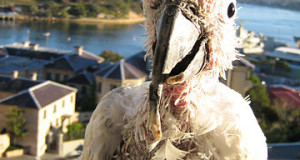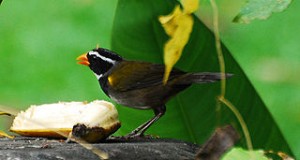Few birds actually live up to the reputations we assign them – owls, for example, have been shown to be less “wise” than most other species when it comes to learning from their mistakes. The ringdove, however, does indeed seem to possess the calm, peaceful demeanor that we have come to associate with doves (although those I kept as a boy begun their admittedly “soft” cooing at 4 AM, rendering my otherwise patient mother far from “calm”!). Kept in a mixed species aviary, even breeding pairs of ringdoves are quite tolerant of smaller birds.
When I began work at the Bronx Zoo, a primary focus of the Ornithology Department was the conservation of the pink pigeon, Nesoenas mayeri. Limited in distribution to the island of Mauritius, off the east coast of Africa, this spectacularly colored bird is highly endangered. It is here that the ringdove’s “accepting nature” came into play. Pigeons and doves feed their young with “crop milk”, a food partially formed from the lining of the mother bird’s crop. Commercial substitutes exist, but none approach the real thing.
In order to obtain as many eggs as possible from the small captive population, we pulled eggs from incubating female pink pigeons and placed them beneath brooding ringdoves (egg removal, within a specific time period, stimulates the female to lay another clutch). The female ringdoves were wonderful foster parents. They produced amazing quantities of crop milk to feed their unusual nestlings, which grew to almost twice the size of their foster moms before fledging. I shall not soon forget the sight of a female ringdove literally perched on the back of a huge nestling pink pigeon while feeding it! Birds raised by foster parents of other species often have problems in breeding with their own species when they mature – fortunately, the fostered pigeons went on to reproduce normally.
The ringdove makes a fine pet and is available in a wide variety of colors, including apricot, white and pied. It has an unusual captive history, and may actually be a mere variant of the wild African collared dove, S.roseogrisea, which was domesticated 2-3,000 years ago. Its actual status is unclear, however, as captives have likely hybridized with related species, such as the Eurasian collared dove and the red-eyed dove. Feral populations of ringdoves live in the USA (Florida, Los Angeles, San Francisco), Italy, Taiwan and England, usually to the delight of local residents.
An interesting perspective on the origins of the ringdove is provided at: http://www.internationaldovesociety.com/Articles/ringneck%20history.htm
 That Bird Blog – Bird Care and History for Pet Birds
That Bird Blog – Bird Care and History for Pet Birds


